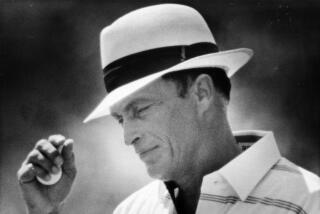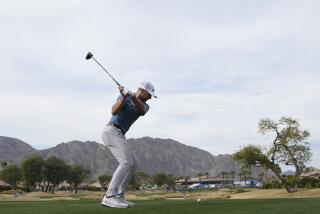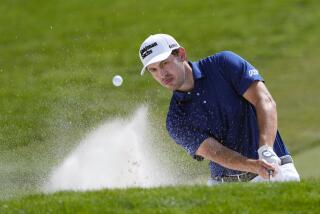ANALYSIS : IT STILL COMES DOWN TO. . . : PALMER AND NICKLAUS
The nice thing about the Skins Game, aside from the excitement it provides when four players sometimes play one hole for more money than some people make in 10, is that it has revived golf’s most famous and enduring rivalry.
Maybe you noticed on television over the weekend how many times the outcome of a hole was left for Arnold Palmer, 56, and Jack Nicklaus, 45, to settle. And with tournaments and even the players all looking as if they came out of a copying machine today, that is not a bad thing for golf.
Palmer and Nicklaus have been going at it on some of the planet’s choicest pieces of real estate for nearly 30 years. Seldom have two athletes of such stature battled one another for so long. Golf fans are blessed to still have them around. It’s like having Jim Brown run with a football or Johnny Unitas throw one again, or Sandy Koufax pitch to Willie Mays and Henry Aaron, or Ted Williams bat, or Joe DiMaggio gracefully glide under a fly ball.
Sure, their skills have eroded with age, but Palmer vs. Nicklaus is still a classic confrontation, reminiscent of the battles between Jack Dempsey and Gene Tunney, Walter Johnson and Babe Ruth, Sam Snead and Ben Hogan.
Palmer’s competitive golf is virtually limited to the Senior tour these days, and Nicklaus plays a limited schedule with the younger set. But as the third Skins Game last weekend showed, neither old pro has lost his combativeness. Palmer, the star of Saturday’s nine holes, masked his frustration at losing a hole with a deft needle. The needle, however, was not always accompanied by a smile.
When Nicklaus blew a short putt on the 17th hole Sunday and allowed Tom Watson to win a skin worth $70,000, Palmer turned to Fuzzy Zoeller and said: “He did it for Watson, why didn’t he do it for me?”
Palmer was alluding to a short birdie putt Nicklaus had made on the ninth hole Saturday to prevent Palmer from winning a $75,000 skin. On the first hole that day, Palmer had made a gift of $15,000 to Nicklaus by missing a 10-inch putt.
“I asked him if he wanted to reciprocate on the last hole, but he didn’t see fit to do so,” Palmer told reporters in front of Nicklaus. “But then that’s the way he is.”
The long rivalry has not always been good-natured. In 1962, his first year as a touring professional, Nicklaus beat Palmer in a playoff for the U.S. Open championship. In the mid-1960s, when Nicklaus ended Palmer’s domination of the Masters tournament, the fat kid with a crew cut from Ohio State became a villain at Augusta. Fans of the gambling, swashbuckling, chain-smoking Palmer cheered Nicklaus’ bad shots.
The Nicklaus-Palmer confrontations became big media events, and when they were paired in a tournament, they outdrew the leaders. Once they were managed by the same agent, Mark McCormack, but Nicklaus broke away and formed his own company, correctly reasoning that Palmer would always be McCormack’s favorite.
Each player won the U.S. Amateur championship and became the best player of his era. Palmer joined the tour in 1955, seven years before Nicklaus. Although Nicklaus ended Palmer’s domination of the game in the mid-1960s, he never matched Palmer’s appeal at the gate or his popularity with the masses.
Today, the two biggest names in golf are rivals, not only on the course, but in business. They are among the world’s leading golf course architects. They are both multimillionaires who fly around the country in their own jets and are seen frequently in television commercials speaking for some of the nation’s largest companies. During the Skins Game telecast on NBC, Palmer plugged Paine Webber and Nicklaus spoke for Manville Corp.
Curiously, the first three Skins Games were played on courses designed by Nicklaus. Bear Creek, in fact, is “A Jack Nicklaus Community” near Murrieta, which is 10 miles north of Temecula on Interstate 15, if that helps. He owns 85% of it and said candidly that the Skins Game was very important to its development.
The Bear Creek area is attractive but somewhat isolated. Nicklaus doesn’t think so, of course. His view is that Bear Creek is within 90 to 100 minutes of 12 million people and will soon develop into a popular resort.
Palmer and Nicklaus first met on a golf course in 1956. Asked separately if they recalled their first game, they both named the same place, time and occasion. Nicklaus was 16 and Palmer 26 when they played an exhibition at Athens, Ohio, on “Dow Finsterwald Day.”
Recalling the occasion the other night, Palmer said he thought Nicklaus was older than 16. “I remember we had a driving contest and I beat him a little. I hit the ball farther in those days.”
Between them, Palmer and Nicklaus have won 131 tour tournaments, Nicklaus leading with 70. Palmer had already won 26, the first one in 1955, when Nicklaus turned professional.
Nicklaus has won more money than Palmer, or any other golfer, but it is the Arnold Palmer Award that goes each year to the leading money winner. The PGA recognized that it was Palmer, with his aggressive and daring style of play, who popularized golf in the late 1950s and early 1960s and was mainly responsible for increasing the size of purses.
Nicklaus is no longer a villain. He has earned the respect of golf fans, even in Augusta, with his consummate skill and wholesome image. Still, he cannot charm a crowd as can Palmer, who clearly was the favorite of the spectators at Bear Creek, as he is wherever he plays today.
By all accounts, the Skins Game is here to stay for a while. Dismissed by many in the media as just another gimmick for television when it first appeared in 1983, it is becoming one of the most popular golf shows in history, judging by its ratings last weekend.
The Saturday telecast from Bear Creek drew an impressive overnight Nielsen rating of 6.3 with a 16% share of the audience. An overnight rating is for the nation’s 12 major markets. National ratings won’t be known until later in the week.
On Sunday, the overnight rating was even better--a 9.8 with an 18 share.
In the Los Angeles market, Sunday’s telecast drew an amazing 15.8 Nielsen rating and a 28 share. By comparison, the Raider-Atlanta game drew a 13.8 rating and a 30 share.
Remarkably, the Skins Game Sunday drew numbers of 4.4 and 7 in Washington, D.C., going head to head with the Redskins.
The word on the ratings from Don Ohlmeyer Productions, which produced the show, was: “Phenomenal.”
After looking at the ratings Monday, Don Ohlmeyer, the independent producer whose risky idea the Skins Game was, said: “I thought the show was a success after the first one, but I never expected to get such numbers.”
Ohlmeyer is not a big fan of ratings, he said. “What made this a successful show was, it was treated as a major event. It made Page 1 of the Los Angeles Times sports section.”
The show’s future does seem bright. Press coverage increased markedly at Bear Creek and even the PGA, which was skeptical of the event at first, now likes it.
“They (the PGA) were skeptical, even cynical at first,” said a spokesman for Ohlmeyer. “The second year, they sent an observer. This year they sanctioned it.”
Indeed, the match at Bear Creek was officiated by the PGA’s Glen Tait. The PGA, in its wisdom, has decided that the Skins Game has not tainted golf. In fact, it really has nothing to do with gambling, since the players are still shooting for somebody else’s money.
Ohlmeyer, an 8-handicapper at the Bel-Air Country Club, said he now has a 20-year agreement with the PGA. “We’re just like a regular stop on the tour now,” he said.
Whether the Skins Game remains in that solid position, however, depends largely on the foursome that plays in it. The exhibition is show business, pure and simple, and to survive on television it needs stars. Ohlmeyer knows that, and so do Palmer and Nicklaus.
As Ohlmeyer said: “This has nothing to do with who wins the British Open.”
It also has nothing to do with who is the leading money winner or who is hot on the tour at the moment. The Skins Game could not survive with a foursome of, say, Raymond Floyd, Craig Stadler, Mark O’Meara and Curtis Strange, or any other group of today’s bland players. They have the skill but virtually no appeal.
The show still needs Palmer and Nicklaus and probably Watson, who dominated the game after Nicklaus became too busy to do so any longer. At the moment, however, no player is dominant. Watson has been in a slump.
Ohlmeyer, as producer, picks one player, and for three years he has wisely selected Palmer. He probably will pick him again for the next Skins Game at the PGA’s complex at La Quinta. Fuzzy Zoeller will return as the defending champion--he won the most money, $255,000, at Bear Creek--and what Ohlmeyer calls a blue-ribbon panel of golf experts will select the others.
It is virtually certain that Nicklaus will be selected again. Lee Trevino, who once made a living hustling on Texas muni courses, would fit nicely in the high-stakes game but so far he has refused to play in it.
Palmer said that to preserve the unique match, the players must be selected for the way they relate to each other and the rapport they have with the crowd.
“Jack and I have been rivals a long time,” he said. “And then Jack and Tom (Watson) were rivals.”
Zoeller, invited this year for the first time, fits the show’s concept well.
He is a free spirit, like Trevino, and can charm a crowd. He kept the others loose, hugging Palmer once and kissing Nicklaus. After winning $150,000 on the 12th hole Sunday, he drove into a fairway bunker on No. 13 and said: “Who cares?”
The way the selection system is structured, in Nicklaus’ view, will keep the show supplied with the stars he also believes are necessary for its survival. The trick for the blue-ribbon panel will be to resist the temptation to select new faces every year. Sadly, professional golf produces few attractive personalities today. The Skins Game can stand one player of lesser stature than Palmer, Nicklaus and Watson, but not two.
Ohlmeyer said Monday that he probably will make one major change in the format next year. The prize money of $450,000 will remain the same, but the 18th hole will be worth more money.
“It would have been better to have the players shooting for $100,000 on the 18th hole Sunday, rather than $35,000,” he said.
He will juggle the money on the other holes to increase the pot on the last one.
More to Read
Go beyond the scoreboard
Get the latest on L.A.'s teams in the daily Sports Report newsletter.
You may occasionally receive promotional content from the Los Angeles Times.










